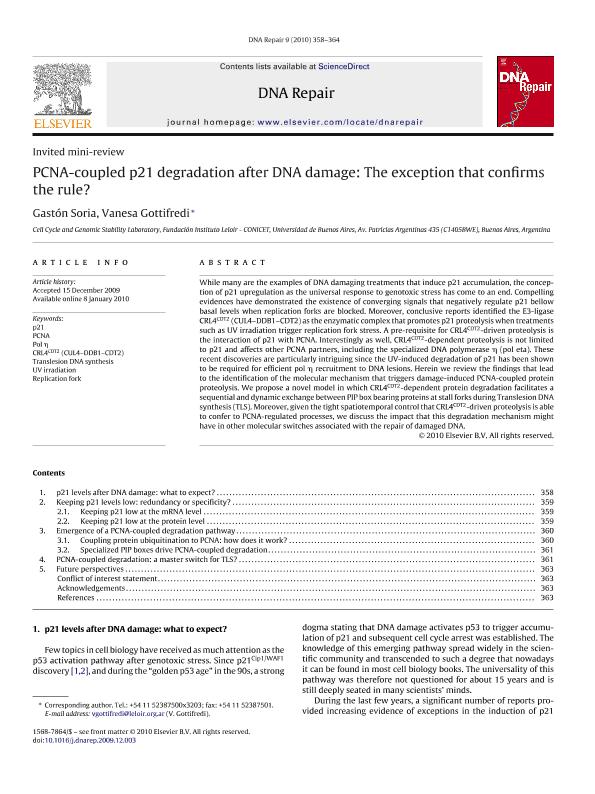Mostrar el registro sencillo del ítem
dc.contributor.author
Soria, Ramiro Gaston

dc.contributor.author
Gottifredi, Vanesa

dc.date.available
2017-02-07T17:08:02Z
dc.date.issued
2010-04
dc.identifier.citation
Soria, Ramiro Gaston; Gottifredi, Vanesa; PCNA-coupled p21 degradation after DNA damage: The exception that confirms the rule?; Elsevier Science; Dna Repair; 9; 4; 4-2010; 358-364
dc.identifier.issn
1568-7864
dc.identifier.uri
http://hdl.handle.net/11336/12642
dc.description.abstract
While many are the examples of DNA damaging treatments that induce p21 accumulation, the conception of p21 upregulation as the universal response to genotoxic stress has come to an end. Compelling evidences have demonstrated the existence of converging signals that negatively regulate p21 bellow basal levels when replication forks are blocked. Moreover, conclusive reports identified the E3-ligase CRL4(CDT2) (CUL4-DDB1-CDT2) as the enzymatic complex that promotes p21 proteolysis when treatments such as UV irradiation trigger replication fork stress. A pre-requisite for CRL4(CDT2)-driven proteolysis is the interaction of p21 with PCNA. Interestingly as well, CRL4(CDT2)-dependent proteolysis is not limited to p21 and affects other PCNA partners, including the specialized DNA polymerase eta (pol eta). These recent discoveries are particularly intriguing since the UV-induced degradation of p21 has been shown to be required for efficient pol eta recruitment to DNA lesions. Herein we review the findings that lead to the identification of the molecular mechanism that triggers damage-induced PCNA-coupled protein proteolysis. We propose a novel model in which CRL4(CDT2)-dependent protein degradation facilitates a sequential and dynamic exchange between PIP box bearing proteins at stall forks during Translesion DNA synthesis (TLS). Moreover, given the tight spatiotemporal control that CRL4(CDT2)-driven proteolysis is able to confer to PCNA-regulated processes, we discuss the impact that this degradation mechanism might have in other molecular switches associated with the repair of damaged DNA.
dc.format
application/pdf
dc.language.iso
eng
dc.publisher
Elsevier Science

dc.rights
info:eu-repo/semantics/openAccess
dc.rights.uri
https://creativecommons.org/licenses/by-nc-nd/2.5/ar/
dc.subject
P21
dc.subject
Pcna
dc.subject
Pol Eta
dc.subject
Crl4cdt2 (Cul4–Ddb1–Cdt2)
dc.subject.classification
Biología Celular, Microbiología

dc.subject.classification
Ciencias Biológicas

dc.subject.classification
CIENCIAS NATURALES Y EXACTAS

dc.title
PCNA-coupled p21 degradation after DNA damage: The exception that confirms the rule?
dc.type
info:eu-repo/semantics/article
dc.type
info:ar-repo/semantics/artículo
dc.type
info:eu-repo/semantics/publishedVersion
dc.date.updated
2017-02-07T13:53:13Z
dc.journal.volume
9
dc.journal.number
4
dc.journal.pagination
358-364
dc.journal.pais
Países Bajos

dc.journal.ciudad
Amsterdam
dc.description.fil
Fil: Soria, Ramiro Gaston. Consejo Nacional de Investigaciones Científicas y Técnicas. Oficina de Coordinación Administrativa Parque Centenario. Instituto de Investigaciones Bioquimicas de Buenos Aires; Argentina. Fundación Instituto Leloir; Argentina
dc.description.fil
Fil: Gottifredi, Vanesa. Fundación Instituto Leloir; Argentina. Consejo Nacional de Investigaciones Científicas y Técnicas. Oficina de Coordinación Administrativa Parque Centenario. Instituto de Investigaciones Bioquimicas de Buenos Aires; Argentina
dc.journal.title
Dna Repair

dc.relation.alternativeid
info:eu-repo/semantics/altIdentifier/url/http://www.sciencedirect.com/science/article/pii/S1568786409003140
dc.relation.alternativeid
info:eu-repo/semantics/altIdentifier/doi/http://dx.doi.org/10.1016/j.dnarep.2009.12.003
Archivos asociados
